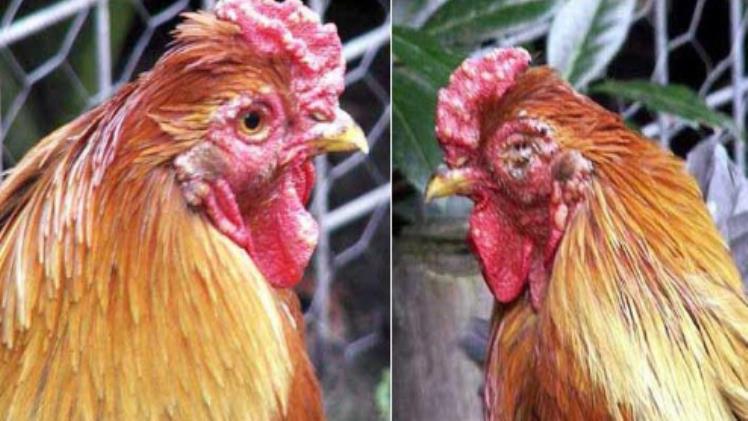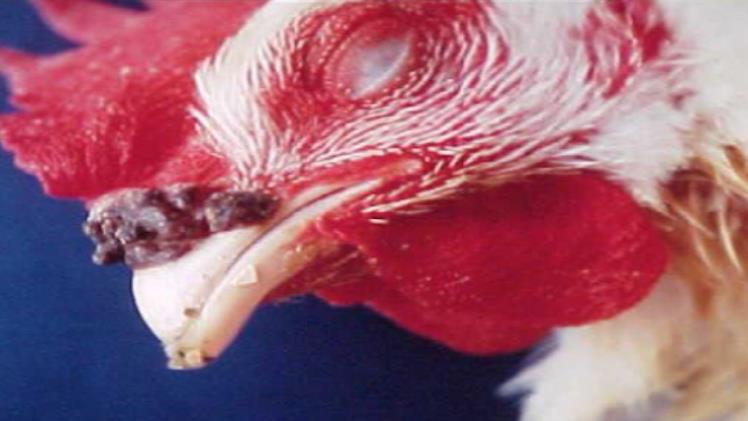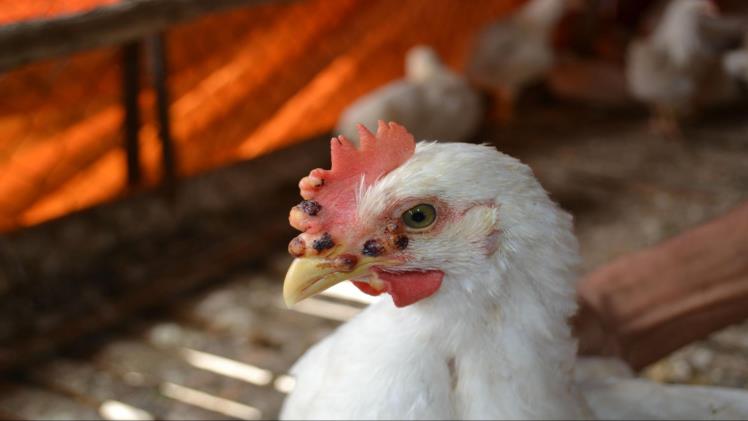Fowl pox is a well-known disease among poultry farmers due to its visible symptoms on chickens. However, many farmers may still be unclear about the causes of the disease, its potential for rapid spread, and the extent of damage it can cause. Today, Thanhga aims to provide comprehensive information on fowl pox, including its transmission, treatment, and prevention.
What is Fowl Pox?
Fowl pox is an infectious disease caused by a virus that commonly affects chickens between 25 and 50 days of age. The disease forms pox lesions on featherless areas of the skin. It causes hyperplasia and degeneration of the epithelial lining in the respiratory tract, including the mouth, pharynx, throat, and esophagus. Severe cases can lead to blindness, diarrhea, pneumonia, stunted growth, and increased mortality. The infection rate ranges from 10% to 95%, with a mortality rate of about 2-3% if left untreated. Additionally, the disease can reduce the commercial value of chickens when they are sold.
Causes of Fowl Pox
Fowl pox is caused by the fowlpox virus, which is resilient and can survive for months in the environment, including on feathers, equipment, and litter. The disease spreads slowly, often through skin abrasions from pecking, and can be transmitted via airborne particles if the virus is present on feathers, skin, or scabs. The primary route of transmission is through insects such as mosquitoes, midges, and lice that bite infected chickens and then spread the virus to healthy birds.
Symptoms
Fowl pox manifests in three forms:
- Cutaneous Form: This affects both adult and young chickens. Lesions appear on featherless skin areas like the comb, wattles, around the eyes, and sometimes on the legs and vent. Lesions initially present as small, white, raised spots that develop into larger, grayish-yellow, warty growths. These lesions eventually burst, dry out, and form pinkish-brown scabs. If infected, the skin can become severely inflamed and necrotic.
- Mucosal Form (Pseudomembranous Form, common in chicks around 3-4 weeks old): Symptoms include difficulty breathing, lethargy, loss of appetite, fever, and the appearance of pseudomembranes in the upper respiratory and digestive tracts. Removing these membranes can cause bleeding or reveal bright red mucous membranes. Thick pseudomembranes in the nose and eyes can cause sinus infections, leading to breathing difficulties and blindness, which can contribute to stunted growth and death. This form is exacerbated by secondary bacterial infections.
- Mixed Form: Typically seen in chicks, this form presents symptoms and lesions of both the cutaneous and mucosal types. If secondary infections occur in poor sanitary conditions, the disease progresses more rapidly, and the mortality rate is higher.
>>> Explore more: Bệnh gà
Treatment
Currently, there is no specific treatment for fowl pox caused by the fowlpox virus, but symptoms can be managed using antibiotics to prevent secondary infections. For cutaneous lesions, scabs can be removed, and the lesions cleaned with diluted saline and treated with mild disinfectants like 2% methylene blue or 1-2% iodine tincture, applied 1-2 times daily for 3-4 days.
For mucosal lesions, clean the pseudomembranes from the mouth with cotton and apply mild disinfectants. Use broad-spectrum antibiotics such as AMOX AC 50%, MEBI-AMPICOLI, or FLOPHENICOL 5%, mixed into the drinking water or feed for the chickens, twice daily for 3-5 days.
Revaccinate the affected flock as needed. Additionally, provide supportive products in the drinking water to boost immunity, such as MEBI-ADE, BCOMPLEX C, or MEBILACTYL 4 WAY WS, with special emphasis on increasing Vitamin A to protect the mucous membranes.

Prevention
Since fowl pox is caused by a virus and spread through blood-feeding insects, effective prevention measures include:
- Ensuring a balanced diet, clean drinking water, and a hygienic environment. Regularly supplement vitamins, minerals, and electrolytes to enhance chicken immunity.
- Maintaining clean poultry houses and managing the environment around them to eliminate insects like mosquitoes, midges, and lice.
- Regularly disinfecting poultry houses and surrounding areas at least once a week to kill pathogens.
- Vaccinating chickens from 7-10 days of age to prevent infection.
In addition, for the mucosal form, farmers can use veterinary medications containing Oxytetracycline or Neomycin administered orally to chickens with fowl pox. Some medications for preventing secondary infections that can be considered include:
AZ GENTA – TYLOSIN: Mix with drinking water or feed, administer for 3-5 days. Dosage: 100g per 300-500 kg of feed per day, or 100g per 50 liters of drinking water, or 100g per 50 kg of feed.
AMPI – COLI Extra: Mix with drinking water or feed, administer for 3-5 consecutive days. Dosage: 1g per 10 kg of feed per day, or 5g per 10 liters of drinking water.
For severe lesions, Damong Spray can be used to treat skin infections and wounds. Spray the solution on the surface of the wound once daily for 3 consecutive days. Keep the spray bottle 15-20 cm away from the wound surface.
During the treatment, provide soft foods like porridge or mash to the chickens to prevent pain and further ulceration of the pox lesions. Additionally, ensure the supplementation of nutrients and vitamins A and C for the entire flock during and after the disease outbreak.

Conclusion
The above information from Mebipha provides insight into fowl pox and its treatment. While fowl pox is not usually extremely dangerous and does not cause massive damage, it can impact the commercial value of chickens. Therefore, farmers should not be complacent and must implement effective preventive measures to ensure the health of their flocks. Wishing all poultry farmers continued success!






